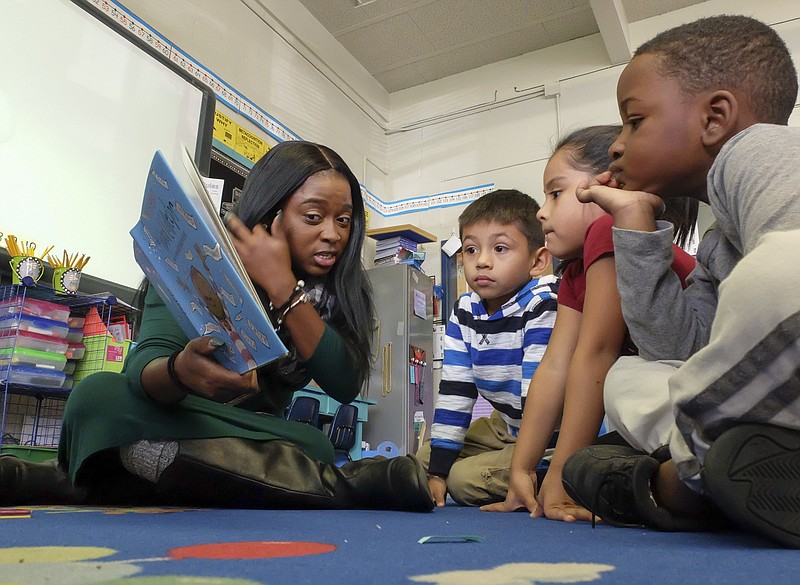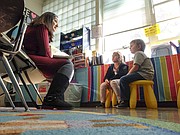Growing up, Brenda Morris doesn't remember reading a lot of books that had characters who looked like her.
Usually, when there was a character that did look like her - an African American girl - the story was a historical one featuring a slave.
"... I couldn't remember a lot of books ... matching me, which led to low self-esteem or insecurities," she said.
As a beginning teacher at a school with teachers who are predominantly white women - as the majority of educators are - she also noticed that many of the books, passed down from teacher to teacher through curriculum and lesson plans, also didn't depict very many students of color or living in unique circumstances.
But DuPont Elementary School in Hamilton County, where Morris is now a kindergarten teacher, has a very diverse student body.
"The definition of a traditional student at DuPont is very unique," she said.
Morris wants her young readers to be able to pick up a book and see themselves in the story. Even kindergartners, many who are just learning to read, notice when they can relate to a book, she said.
HOW YOU CAN HELP
For more information about the “Rich Lit” initiative at DuPont Elementary or to donate to the fundraiser, contact Brenda Morris at morris_brenda@hcde.org.
When students listen to a story about a family structure or situation that isn't like their own experience, they can withdraw, Morris said. But they also notice when the characters in the books do look like them.
This holiday season, Morris and her colleagues are working to change that by ensuring the more than 300 students at DuPont have books that "they can see themselves in."
The educators are trying to raise at least $5,000 so they can handpick books for each one of their students - books depicting girls as superheros, books depicting students of color going to school or playing games just like any other child, books about foster children or children being raised by their grandparents, whatever situation their students might be facing.
They're calling the initiative "Rich Lit."
Literacy experts say this type of initiative is important, not just for minority students to see themselves in the books they are reading, but for all children to be exposed to different types of people in literature.
Children need to see themselves in books
At DuPont Elementary, more than 56% of students are students of color, but only about 10-14% of children's books published annually feature students of color, said Krista Aronson, a professor of psychology at Bates College in Maine.
Aronson and her team created the Diverse BookFinder, a tool that helps educators and parents find books that feature a wide variety of races and cultures and analyzes trends and storylines.
Research shows that students who can see themselves in books, especially books in which race or culture is not the central theme, are more engaged.
"It's really nice if a book about a lost tooth can depict a child who looks like my child," said Aronson, who is biracial and the mother of biracial daughters.
The Diverse BookFinder project calls those books "any child" books, ones with characters that could be interchangeable without affecting the main message of the story.
Morris recently read "The Word Collector" by Peter Reynolds to a small group in her classroom. The group, consisting of Hispanic, black and white students, didn't seem to notice that the character, Jerome, had brown skin.
In the story, Jerome explores how it feels to learn, or collect, new words. But a child with any skin color could have been Jerome. His race wasn't central to the plot.
"I think 'any child' books can be very powerful," Aronson added.
DuPont Principal Ruthie Panni said the school makes it a point to value all students and celebrate diversity, and through the initiative, hopes to make that clear to students.
"When I say I value diversity and inclusivity, I want to show that I mean it," Panni said. "I think having these types of books adds value to different cultures and different life circumstances."
Pick stories that depict different groups of people living and working together
But stories featuring diverse characters aren't just important for students of color or minority groups. All kids can benefit from reading them, especially children who might not be exposed to other children who don't look like them, Aronson explained.
"We often think that students are not talking about race and culture and having conversations like that, but that's not the case," Aronson said. "We live right now in segregated societies, and we think of school or work as places where we come in contact with people who are different from ourselves. ... That's going to be increasingly common, and we need to prepare our children to be successful in those environments."
Aronson's team found that children who read books depicting different groups of people living and working together are often more open to interacting with others.
"There shouldn't be any fighting; the book should be about friendship," Aronson said. "Stories that children will see as typical stories, that they can relate to and can imagine really themselves in."
All parents want to raise kind, well-liked children, she said.
Being exposed to books that depict children of other races and different cultural customs can help students think differently about another child in their classroom and, some research shows, can even help students overcome biases or prejudices against other groups.
Pick books on topics you know interest your child
Both personal and classroom libraries should include different types of books and stories - fiction, nonfiction, informational books, interactive books and books across genres from fairy tales to mysteries to science fiction.
Most literacy experts agree that children, like any person, are more likely to read about something they are interested in.
In Morris' classroom one afternoon, 5-year-old Grayson selected a book to read solely because of the picture on the cover.
"It was a motorcycle," Grayson exclaimed, pointing excitedly at the red motorbike under the title. "I like motorcycles!"
TIPS FOR PARENTS
— Choose books that depict characters that look like your child or their friends— Choose stories that depict different groups of people playing or working with one another— Choose books that don’t just depict animals, but human children— Pick straightforward storylines or stories with character development— For younger readers, choose books with familiar words that also include some words that challenge them— As your child gets older, provide a variety of types of books (different genres, fiction vs. nonfiction, formats, etc.)— Choose books on topics that your child is interested in or wants to learn more about
The Diverse BookFinder that Aronson's team created categorizes books in several ways, such as by the race of children depicted in the pictures books, or by topic like oppression and resilience, folklore or incidental. Books can also be searched based on whether or not they are informational or biographies.
But books that are both engaging and feature diverse characters can be extremely hard to find.
Morris emphasized her own struggle, as did her colleague Sonal Patel, the literacy coach at DuPont who said she didn't even realize that she often bought books for her brown-skinned nieces that didn't feature characters like them.
When she bought them "I Am Malala," a book about the Pakistani teenager who was awarded the Nobel Peace Prize, they were so excited, she said.
The team at DuPont is excited to pick out books specific for each child. Teachers often know a child's interests almost as well as their parents do, and many already have specific books in mind for specific children.
At a recent meeting, teachers reviewed examples of diverse books the school's librarian Donna Hatmaker had laid out and shared ideas about what book might be a good fit for specific children.
"I'm excited to be thinking about kids and their individuality. I think about that anyways," said Rachel Smith, a second grade teacher at DuPont. "I'm excited to be thinking about each child and what they are interested in and what they are like and finding books for everyone."
Other educators in Hamilton County are also working to improve the books available to their students.
Ashley Cox, an English teacher at The Howard School, runs Nooga Chat, a book club for students at Howard and surrounding schools, that selects books based on student feedback that reflect their own experiences to read. She has also fundraised to expand her own classroom library.
Moms for Social Justice, an activist group in Chattanooga, launched the Classroom Library Project in 2018, and seeks advice on what type of books to provide in specific libraries at schools.
Morris hopes to curate a list of books that DuPont educators have discovered and vetted, similar to the Diverse BookFinder, and share those lists with other educators and community members.
The school has raised $3,000 of its $5,000 goal to purchase books for their students this fall. They have a special celebration scheduled for Dec. 17 where students will receive their books.
Contact Meghan Mangrum at mmangrum@timesfreepress.com or 423-757-6592. Follow her on Twitter @memangrum.

